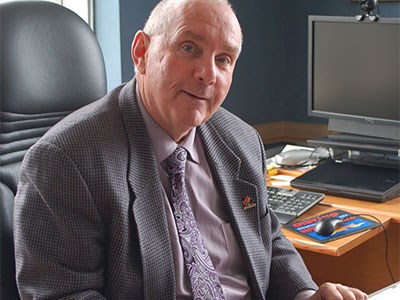After developing its Timmins 2020 strategic plan in 2012 during city’s centenary, the City of Timmins is now starting to put plans into action, and housing, development and infrastructure are among the priorities for city council in 2014.
Mayor Tom Laughren said the city is looking to plan ahead for capital projects from a long-term perspective.
“Administration endeavoured on that last year, so that’s going to help us, not so much on this budget, but future budgets,” Laughren said. “But we are looking at some of the shortcomings we have as it relates to that.”
Housing remains a major issue for the city, and council’s housing strategy is expected to be released this month. It will be a 20-year look at all aspects of housing, including that geared to seniors’, affordable, assisted, apartments, additional development.
When the economy booms, housing becomes more scarce, leaving the city short, he noted. Timmins currently has a 0.09 per cent vacancy rate.
Some of the housing shortage has been alleviated with the completion of two seniors’ complexes; 61 long-term beds have become available at the recently opened Extendicare, while St. Mary’s Gardens, a former hospital site now operated by Autumnwood in downtown Timmins, should provide another 150 to 200 apartments and rooms that offer different levels of care for residents.
There has also been interest from various developers in putting up apartments in town.
“We do have some people on the housing front that are building apartments, so we’ve got probably close to 100, 110 units—some in the construction progress right now, some that have been approved but construction hasn’t started,” Laughren said. “Other people are looking, so there’s a definite interest.”
This spring, the city will be doing some modifications on a water reservoir, which Laughren said will give developers water access. The city won’t service the lots, but he hopes developers will see the potential and use the capacity to open up about 2,500 residential lots.
Development is also expected to expand in the city’s newest industrial area.
In 2012, recognizing it had a dearth of developed commercial land, the city developed a new industrial area. Located off Algonquin Boulevard, the land is fully serviced and represents about 40 acres.
Developers and entrepreneurs have consistently sought to set up on the main strip, but stretching further towards Sudbury would put a strain on the city’s infrastructure, Laughren said. Instead, the city chose to locate the industrial area behind Timmins Square, a retail area.
It doesn’t give developers the highway frontage they seek, but they’re close by. And the area is prime for institutional, light industrial and commercial development, Laughren said.
“We’re looking forward to more development taking place in there, and not only in 2014 but in the coming years,” Laughren said.
Timmins’ infrastructure also requires some attention. The city’s secondary sewage treatment plant, which is currently under construction on Airport Road, will cost $80 million to complete.
The plant, which is being constructed to help the city meet the regulations resulting from the Walkerton safe drinking water inquiry, is the largest construction project, from a monetary perspective, in the city’s history. Laughren said the city has received some government funding, but more is required to cover the costs.
That won’t be the only major investment the city will be required to make.
“From a community perspective, over and above the housing challenges, over the next 10 years, we’re probably looking at an investment of $100 million on the sewage side,” Laughren said.
Work will include upgrading plants and pumping stations; it’s a priority project for this council, and will continue to be a priority for the next council, as well, he said.
Infrastructure needs extend to roads as well. Timmins has tried to use its share of the federal gas tax money to its advantage, as well as money from its roads construction budget. Laughren estimates the city spends between $8 million and $10 million a year on roads upgrades.
“Future councils will be challenged—communities will always be challenged—with trying to find enough money to do all that kind of good stuff,” he said.
But he’s still optimistic that the North has lots to offer.
“We believe there’s a lot of opportunities and that Northern Ontario still has a great story to tell,” he said.




